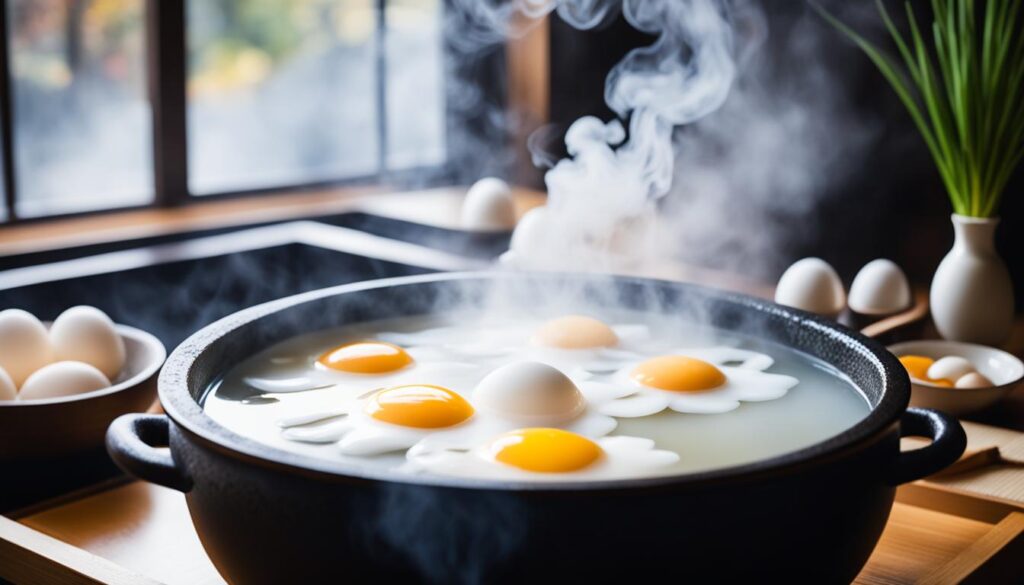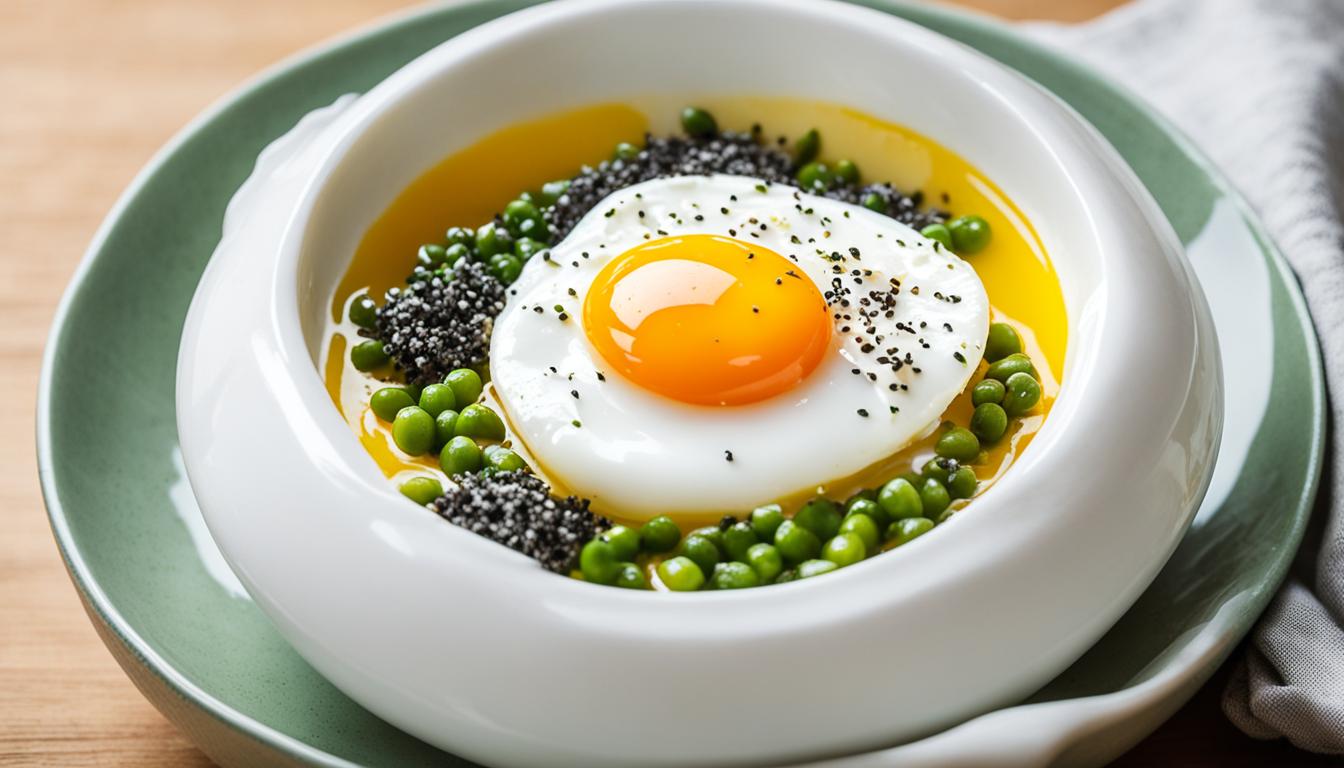Welcome to our guide on how to make the perfect onsen tamago, a traditional Japanese soft-cooked egg recipe. Onsen tamago is known for its silky texture, tender whites, and warm, runny yolks. In this article, we’ll explore different methods to achieve this culinary delight and share tips for serving and enjoying it.
Long before modern cooking gear, the Japanese used hot spring waters to achieve the desired texture of onsen tamago. However, you don’t need an actual hot spring to make this delicious treat at home. Whether you have an immersion circulator, a pot of water, or even a rice cooker, we’ve got you covered.
Next, we’ll dive into the traditional method using an immersion circulator. This approach ensures precise temperature control, resulting in consistently delicious onsen tamago. If you don’t have an immersion circulator, don’t worry! We’ll also explore a quick and easy method using a pot of water.
For those seeking a foolproof technique, we’ll introduce the rice cooker method. With a rice cooker’s “keep warm” function, you can achieve consistent results every time. Plus, we’ll discuss the importance of dashi broth, the flavorful accompaniment commonly served with onsen tamago.
When it comes to serving and enjoying onsen tamago, the possibilities are endless. From pairing it with rice to incorporating it into carbonara, the creamy texture of these eggs adds depth and richness to a variety of dishes. Get ready to tantalize your taste buds and explore the versatility of this traditional Japanese delicacy.
Before we begin, it’s important to note safety considerations and proper storage techniques. While onsen tamago is a delicious treat, it’s crucial to handle eggs safely and cook them to the appropriate temperatures to prevent any foodborne illnesses. We’ll provide tips on how to ensure food safety and how to store onsen tamago for optimal freshness.
Now that you have a taste of what’s to come, let’s dive into the world of onsen tamago and discover how to create the perfect Japanese soft-cooked eggs in your own kitchen!
The Traditional Method: Immersion Circulator
When it comes to making onsen tamago at home, using an immersion circulator is the easiest and most reliable method. With this technique, you can achieve the perfect soft-cooked eggs without the need for an actual hot spring.
To start, set your immersion circulator to a temperature of 145°F (63°C). This precise temperature will ensure the eggs cook evenly and result in the desired custardy texture.
Next, carefully place your eggs into a heatproof container or a bag suitable for immersion cooking. Make sure the eggs are fully submerged in the water to ensure even cooking.
Now, it’s time to let the immersion circulator do its magic. Cook the eggs for 45 minutes to 1.5 hours, depending on your preference for yolk thickness. The longer you cook the eggs, the thicker the yolk becomes.
While the eggs are cooking, you can prepare other components of your onsen tamago dish or simply relax and wait for the eggs to finish cooking.
Once the cooking time is complete, carefully remove the eggs from the water bath. You can gently crack and peel the eggs, or serve them directly in their shells for an authentic onsen tamago presentation.
The immersion circulator method ensures precise temperature control and guarantees consistently delicious onsen tamago every time.
Why Choose the Immersion Circulator Method?
The immersion circulator method stands out for its convenience and reliable results. Here are a few reasons why it’s worth considering:
- Consistency: The precise temperature control provided by the immersion circulator ensures that each onsen tamago you make turns out perfectly cooked.
- Effortless Cooking: Once you’ve set the temperature and placed the eggs, there’s no need for constant monitoring. You can focus on other tasks while the immersion circulator does the work for you.
- Customizable Results: With the immersion circulator method, you have control over the yolk consistency based on your preferred cooking time.
- Repeatability: Once you find the perfect cooking time for your desired yolk thickness, you can replicate the same results for future batches of onsen tamago.
The Quick and Easy Method: Pot of Water
Don’t have an immersion circulator? No problem! You can still enjoy delicious onsen tamago by using a pot of water. This quick and easy method yields satisfying results in no time.
To get started, you’ll need:
- A pot of water
- Fresh eggs
- A digital thermometer
Follow these steps to make your easy onsen tamago:
- Fill the pot with water and bring it to a temperature of 167°F (75°C). This higher temperature and shorter cooking time will create a temperature gradient within the eggs, resulting in firmer whites and warm, runny yolks.
- Once the water reaches the desired temperature, carefully add the eggs to the pot.
- Cook the eggs for 13 minutes, making sure to maintain the temperature throughout the process. Use a digital thermometer to monitor the water temperature and adjust the heat as needed.
- After 13 minutes, remove the eggs from the pot and transfer them to a bowl of cold water to stop the cooking process.
Tip: If you prefer a softer or firmer yolk, you can adjust the cooking time accordingly. Experiment to find your perfect onsen tamago consistency.

The quick and easy pot of water method allows you to enjoy the deliciousness of onsen tamago without the need for specialized equipment. The temperature control is essential, so be sure to use a digital thermometer for accuracy. With a little practice, you’ll master this method and impress your guests with your homemade onsen tamago.
The Foolproof Method: Rice Cooker
If you’re looking for a foolproof way to make traditional Japanese soft-boiled eggs, the rice cooker method is your answer. Using a rice cooker with a “keep warm” function allows for precise temperature control, ensuring consistent and delicious results every time.
Here’s how you can use a rice cooker to make delicious onsen tamago:
- Fill the rice cooker pot with a combination of boiling water and tap water to achieve a target temperature of around 160°F (71°C). This temperature is ideal for achieving the traditional soft-cooked consistency.
- Add the cold eggs directly into the pot. You can cook multiple eggs at once, depending on the size of your rice cooker.
- Set the timer for 20-30 minutes, allowing the eggs to cook slowly in the warm water. The rice cooker will maintain a constant temperature throughout the cooking process.
- Once the eggs are cooked to your desired consistency, carefully transfer them to a cold water bath to stop the cooking process. This step is crucial for achieving the perfect texture of the onsen tamago.
The rice cooker method is convenient and guarantees consistent results every time. By maintaining a constant temperature, the rice cooker creates the ideal environment for producing delicious onsen tamago. The gentle cooking process results in a silky-smooth texture with warm, runny yolks that are irresistible.
The Importance of Dashi Broth
Onsen tamago, the traditional Japanese soft-boiled eggs, are often served with a flavorful broth known as dashi. This broth is made from a combination of soy, mirin, dashi, and sugar, creating a balanced and savory flavor that perfectly enhances the taste of the eggs.
The ideal ratio of dashi to soy and mirin may vary depending on personal preference, but commonly used ratios include a 4:1:1 ratio or a 3:1 ratio of dashi to a mixture of soy and mirin. Feel free to adjust the ratios to suit your own taste.
This dashi broth can even be made ahead of time and stored in the fridge, making it convenient for future use. Its versatility and ability to enhance the flavor of onsen tamago make it an essential component of this traditional Japanese dish.

Ingredients for Dashi Broth:
- Dashi (Japanese soup stock)
- Soy sauce
- Mirin (sweet rice wine)
- Sugar
Instructions:
- In a saucepan, combine the dashi, soy sauce, mirin, and sugar.
- Bring the mixture to a boil over medium heat, stirring until the sugar has dissolved.
- Reduce the heat and let the broth simmer for about 10 minutes to allow the flavors to meld together.
- Remove the saucepan from the heat and let the broth cool.
- Once cooled, strain the broth to remove any solids.
Now you have a delicious dashi broth ready to be served with your onsen tamago. Enjoy the rich and comforting flavors of this traditional Japanese soft-boiled egg dish!
Serving and Enjoying Onsen Tamago
Now that you’ve mastered the art of making onsen tamago, it’s time to explore the various delicious ways to serve and enjoy these Japanese soft-cooked eggs. Whether you prefer traditional accompaniments or want to get creative with your own unique twists, onsen tamago can elevate any dish to a whole new level.
1. Classic Soy-Dashi Broth
One traditional and popular method of serving onsen tamago is to pour a chilled soy-dashi broth over the eggs. This broth, made from a combination of soy sauce, dashi, and other seasonings, complements the creamy texture and rich flavor of the eggs. The salty umami notes of the broth beautifully balance the delicate sweetness of the yolks, creating a harmonious taste sensation.
Get ready to tantalize your taste buds with this authentic Japanese pairing that highlights the unique qualities of onsen tamago.
2. Delicious Toppings
Onsen tamago can also be served as a delicious topping for a variety of dishes. Try placing a perfectly cooked onsen tamago on a bowl of steaming hot rice for a simple yet satisfying meal. The warm, runny yolk mixes with the rice, creating a delightful and comforting combination.
“The soft, custardy texture of onsen tamago pairs exceptionally well with noodle soups like ramen or udon. The eggs add a velvety richness to the broth, enhancing the overall flavor and elevating your soup experience.” – Ramen Lover Magazine
For those who enjoy the popular Japanese dish gyudon, a bowl of rice topped with simmered beef and onions, adding an onsen tamago brings an extra layer of indulgence to the meal. The creaminess of the egg beautifully complements the savory beef and sweet onions, creating a perfect balance of flavors.
3. Versatile Incorporation
Onsen tamago is an incredibly versatile ingredient that can enhance a wide range of dishes. Imagine adding the soft, custardy eggs to a creamy carbonara pasta for a unique twist on the classic Italian dish. The richness of the eggs blends beautifully with the cheese and enhances the overall creaminess of the sauce.
With your culinary creativity, the possibilities are endless. From salads to sandwiches, onsen tamago can take your favorite recipes to new heights, adding a luxurious and velvety texture that will impress even the most discerning palates.
| Popular Serving Ideas for Onsen Tamago |
|---|
| Bowl of Rice |
| Noodle Soups (Ramen, Udon) |
| Gyudon (Simmered Beef Rice Bowl) |
| Carbonara Pasta |
| Salads |
| Sandwiches |
Experiment with different serving styles and find your favorite way to enjoy onsen tamago. Let your taste buds guide you on a culinary adventure that combines tradition with personal flair.
Safety Considerations and Storage
While onsen tamago is a delicious treat, it’s important to be aware of the potential health risks associated with consuming undercooked eggs. Onsen tamago is typically cooked at a temperature below the recommended temperature for fully cooked eggs, which may increase the risk of salmonella contamination.
If you have concerns about food safety, there are a couple of precautions you can take. One option is to use pasteurized eggs, which have been treated to eliminate harmful bacteria. Alternatively, you can opt for fully cooked eggs, where the yolks are completely set and no longer runny.
After making onsen tamago, it’s essential to store them properly to maintain their freshness and safety. Store your onsen tamago in the refrigerator and consume them within a couple of days to minimize the risk of bacterial growth. When reheating, bring the eggs to room temperature or use a gentle water bath to ensure even heating without overcooking.
